HUM A low tone caused by AC currents (60 Hz in the USA)
SOUNDS LIKE “mmmmm”, a low tone, a bit sharp of Bb
 Guitar Noise Manual by PedalSnake®
Guitar Noise Manual by PedalSnake®
.
 Jody Page, PedalSnake’s inventor and lifelong pro guitarist, is an electrical engineer (a member of NASA’s Space Foundation Hall of Fame, no less) with special training in electrical noise. In the Guitar Noise Manual, Jody starts by breaking down guitar rig noise into 6 types:
Jody Page, PedalSnake’s inventor and lifelong pro guitarist, is an electrical engineer (a member of NASA’s Space Foundation Hall of Fame, no less) with special training in electrical noise. In the Guitar Noise Manual, Jody starts by breaking down guitar rig noise into 6 types:
1) BUZZ 2) HUM 3) HISS 4) DIGITAL NOISE (WHINE) 5) POWER SUPPLY NOISE 6) CABLE MICROPHONICS
For each noise, Jody explains its causes, then offers a targeted set of solutions. Also included are several helpful articles on general best-practices for noise reduction.
.
Dealing With HUM
Contents
How is the HUM Getting Into Your Rig?
If it DOES (go away when you turn your guitar down)
If it DOES NOT (go away when your turn the guitar down)
If none of the solutions above help with the HUM…
Before We Start…
.
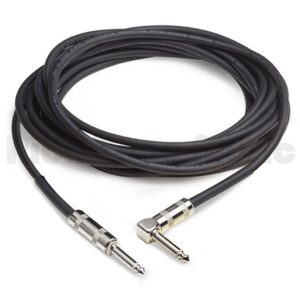 Make sure you have a good guitar cord
Make sure you have a good guitar cord
By good, we mean “not broken”. A simple jiggle test at both ends will usually tell you. Then consider…
.
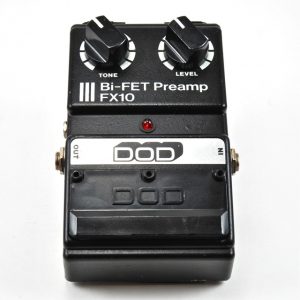
Boosting your guitar signal
Right away this can strike a lethal blow to any noise that might crop up. Anyone and everyone should do it. See Improving Signal-to-Noise Ratio (SNR). With a hotter guitar signal, you can…
.
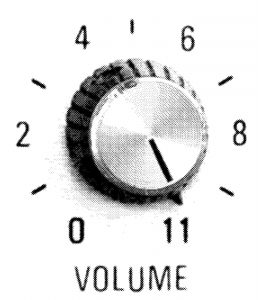 Reducing your gain
Reducing your gain
Gain is not free. The more gain you have, from all pedals and amps, the more noise you will have. Amps at 11 can give you that extra edge, but you may be just as happy (and quieter) at 9.
So What’s the Deal With HUM?
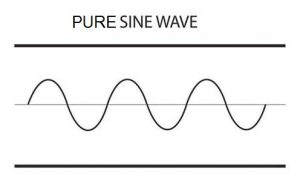 Like BUZZ, HUM almost always comes from the AC power source (120VAC in the USA, at 60Hz).
Like BUZZ, HUM almost always comes from the AC power source (120VAC in the USA, at 60Hz).
Unlike BUZZ, there is nothing wrong with your power when you get HUM. What you are hearing just the pure, smooth, 60 Hz voltage “sine wave” that the power company intended. You will notice it is a bit sharp of Bb.
![]() In the case of leaky caps in an amp’s power supply, hum could be at a “rectified” 120 Hz, but it’s still a bit sharp of a Bb.
In the case of leaky caps in an amp’s power supply, hum could be at a “rectified” 120 Hz, but it’s still a bit sharp of a Bb.
.
HUM sounds different from BUZZ because it contains no high frequency component. Rather than the “brrrrrrr” you get with BUZZ, HUM sounds like a smooth “mmmmm”…a low bass tone.
How is the HUM Getting Into Your Rig?
The first thing, as with any kind of noise, is to decide whether the HUM is:
conducted noise (comes through wires into your gear)
radiated noise (comes through the air into your ax pickups).
How do you decide? The solution is easy:
Does it go away when you turn the ax down?
If it DOES (go away when you turn your guitar down):
EMI and RFI
If it does go away, the HUM is radiated through the air into your pickups. (This is called EMI, or “electromagnetic interference”).
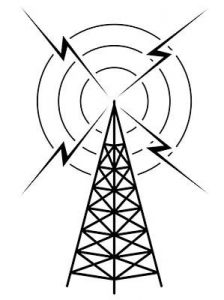 When radiated through the air, EMI can also be called RFI (Radio Frequency Interference).
When radiated through the air, EMI can also be called RFI (Radio Frequency Interference).
Now you may say at this point “radio frequencies are pretty high, right?…like kilohertz and megahertz and stuff”.
Well yes, they usually are. But as we shall see below, this RFI can get into your pickups at the AC power frequency…which is only 60 Hz!
To be sure, the higher the frequency, the better its ability to induce voltage into antennas (like the coils in your pickups). But low frequency AC can involve so much current, especially in the power transformers of tube amps, the magnetic fields are so strong they can act like a radio transmitter.
 Sniffing it Out
Sniffing it Out
You may be using single coil pickups and standing too close to a power transformer in an amp, or some other “HUM source”. You can “sniff out” these kinds of sources.
Turn your amp and ax all the way up, and walk around, holding the pickups up near different suspected sources of HUM (this works best with single coils, not humbuckers).
For example, hold the ax up close to where the power cable goes into the back of a tube amp (the power transformer is here), and you will hear it.
Or, if you can, just move away from the noise source. If you can’t, read on.
.
Humbucking
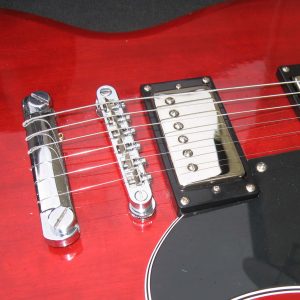 Whether it be HUM or BUZZ, humbucker pickups generally solve most any type of radiated noise problem. These are almost essential for high-gain playing.
Whether it be HUM or BUZZ, humbucker pickups generally solve most any type of radiated noise problem. These are almost essential for high-gain playing.
If you prefer single coils, you can make a “humbucker” out of 2 single coil pickups. All you need is one reverse-polarity pickup.
When a normal pickup is combined with a rev-pol pickup, hum is canceled (this is how a humbucker pickup works, it has 2 coils of reverse-polarity).
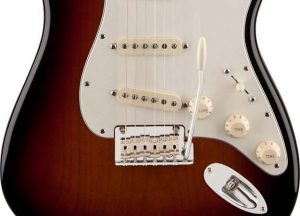 In an ax with 3 single coil pickups, like a Strat, if it is not already there, you can install a reverse-polarity pickup in the middle position. Then positions 2 and 4 (on the 5-way switch) will combine the rev-pol pickup with a normal one, and cancel noise.
In an ax with 3 single coil pickups, like a Strat, if it is not already there, you can install a reverse-polarity pickup in the middle position. Then positions 2 and 4 (on the 5-way switch) will combine the rev-pol pickup with a normal one, and cancel noise.
Newer Strats should already have this feature. Older Strats did not.
If it DOES NOT (go away when your turn the guitar down)
Then the HUM is not radiated through the air into your pickups. It is conducted noise, which finds its way into your rig thru the wiring. In this case, HUM may be caused by one or more of these:
A ground loop in your rig
“Ground loop” is an overused term. Just about any time there is noise, somebody is going to say it is a “ground loop”.
But, if you have HUM, and it does not go away when the ax is turned down, then it may be an AC ground loop. In all other types of noise (buzz, hiss, etc.), a ground loop is almost never the cause.
To shut down ground loops, try the following tricks:
Use the same AC phase
The quick solution to reduce the effect of ground loops is to make sure all of your amps, power supplies for pedals, and any other audio gear that requires AC power, are on the same 120VAC phase (of the 240VAC).
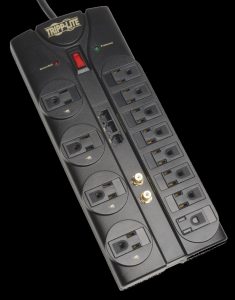 With your personal rig, you can easily ensure this by plugging it all into the same AC power outlet.
With your personal rig, you can easily ensure this by plugging it all into the same AC power outlet.
It is also a good practice for all the band’s audio gear onstage to be on the same 120VAC phase (of the 240VAC). This only applies if there are connections between gear, like an amp going direct into a mixer onstage.
When on the same phase, any spurious AC ground voltages induced into the gear (there are always some) are in the same phase (we won’t explain, but trust us, this helps).
If you have a HUM problem, ways to make sure all gear is put on the same AC phase is to:
Plug it all into the same AC outlet (this is the easiest way). Audio does not require huge amounts of power. A 15A breaker will handle 1800 watts (do not try this if you play with Van Halen, the Rolling Stones, etc.)
If the same outlet is not feasible, plug all gear into the same circuit breaker. If you can find the breaker panel, you can experiment to find out which outlets are on the same breaker. If the same breaker is not feasible…
Plug all gear into outlets on the same AC phase. For breakers on the same side of the breaker panel, every other single 120VAC breaker will be on the same phase (240VAC breakers actually connect to both sides of the panel) .
Lighting and other stuff can go on another breaker, or the other AC phase.
If you do all of this, and still have HUM, you will have to troubleshoot. Start by isolating certain things.
.
.
Signal isolation
If you use stereo amps, and have any hum at all, then the signal cable(s) to one amp should go through a signal isolation transformer. EbTech makes a good one called the HE2.
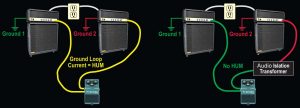
If you have 3 amps, then isolate 2 of them. (You can always leave one amp un-isolated.)
This goes for any devices powered by AC that have signals running between them. This is more important with gear that draws a lot of current, like tube amps (it takes a lot of juice to make tubes glow!), because the power transformers carry more current, and thus induce more voltage into the grounded metal chassis.
These ground voltages may be tiny, but it doesn’t take much for AC ground currents to flow between devices.
When connected together, preamps or signal processing gear are usually not a problem. Their transformers are small, and carry much less current. So their metal chassis stay relatively voltage free.
But if they connect to a higher powered device, ground currents could still become a problem. For this reason, a few preamp devices will have signal isolation transformers built in. Even more will have isolated transformers for power supplies that plug into the wall to power them.
Power supply isolation
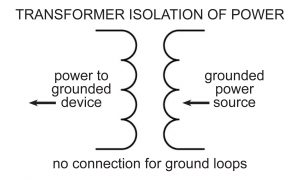 You may need to isolate some power supplies.
You may need to isolate some power supplies.
Even if you isolate signal to stereo amps, you may have pedals that connect to different amps, but are powered by one power supply. This can cause ground loop current to flow.
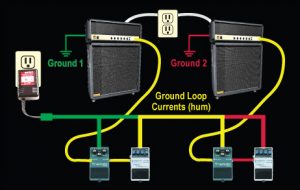
Break the loop by using two separate isolated power supplies.
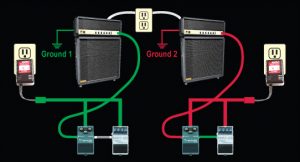
The same isolation of power supplies can apply to an effects loop…even though the cables connect to the same amp…on the same metal chassis!
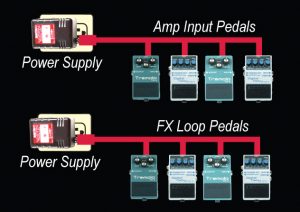 Powerful power transformers in tube amps can induce AC currents into the grounded metal chassis. Connecting between different points on the chassis can cause ground loop currents to flow through that connection, and induce HUM into your sound.
Powerful power transformers in tube amps can induce AC currents into the grounded metal chassis. Connecting between different points on the chassis can cause ground loop currents to flow through that connection, and induce HUM into your sound.
So, if you have an effects loop and have HUM, try isolating the power between the two pedal chains. Power the pedals that go to the amp input on one isolated power supply. Power pedals that go to the effects loop on another.
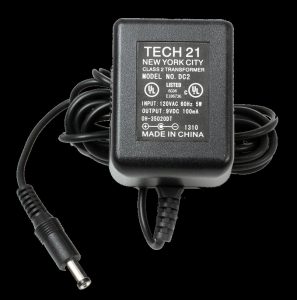 This is actually a good practice in general. Even if HUM is not annoying, isolating power chains can reduce what little HUM there is.
This is actually a good practice in general. Even if HUM is not annoying, isolating power chains can reduce what little HUM there is.
Standard wall warts make fine isolation tools, as long as they are true isolated Class 2 Transformers. Most of the good ones are, like those from Boss, Dunlop, etc.
This leads us to…
Noisy power supplies
Not all power supply noise is the same. It depends upon the circuits in the supply. A noisy supply will most often HUM, but it can also cause BUZZ, HISS, or WHINE (like digital noise).
A noisy power supply can be caused by 4 things:
- A power supply not designed to be quiet for audio.
- A damaged power supply.
- An overloaded power supply.
- A power supply too close to a pedal.
For more, see our article Dealing With POWER SUPPLY NOISE.
Hummy Amp
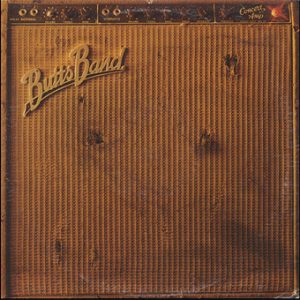 Of course, an amp may HUM on its own. And it’s not because it doesn’t know the words.
Of course, an amp may HUM on its own. And it’s not because it doesn’t know the words.
You can tell by unplugging everything from the amp. If you still hear HUM, well there you go.
 This is usually a leaky cap in the power supply. In this case, the HUM would be heard as 120 Hz (the rectified version of 60 Hz.) This is a little sharp of Bb (the lowest Bb on a guitar.)
This is usually a leaky cap in the power supply. In this case, the HUM would be heard as 120 Hz (the rectified version of 60 Hz.) This is a little sharp of Bb (the lowest Bb on a guitar.)
Old amps sometimes need recapping to fix hum. Or a cheaper amp may have cheap caps. Or there could be another problem. Some new tubes may be needed.
Either way, some kind of repair or a better amp is what you need.
If none of the solutions above help with the HUM…
 …then you may have some gear in need of repair. Troubleshoot until you find out which gear is the culprit (it is usually the amp).
…then you may have some gear in need of repair. Troubleshoot until you find out which gear is the culprit (it is usually the amp).
If you can unplug all the guitar cables from the amp, turn the amp volume up, and the HUM is still loud enough to be annoying, then haul that amp down to the nearest repair shop.
Or you may just need a better amp. We all plan to get one someday, right?
For more, see:
Improving Signal-to-Noise Ratio
.
